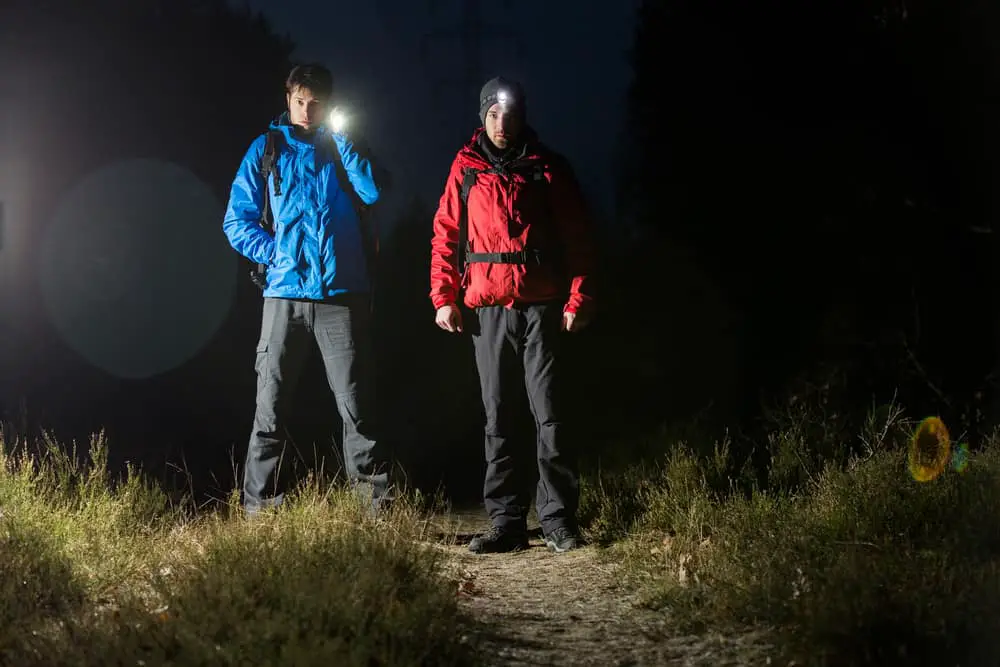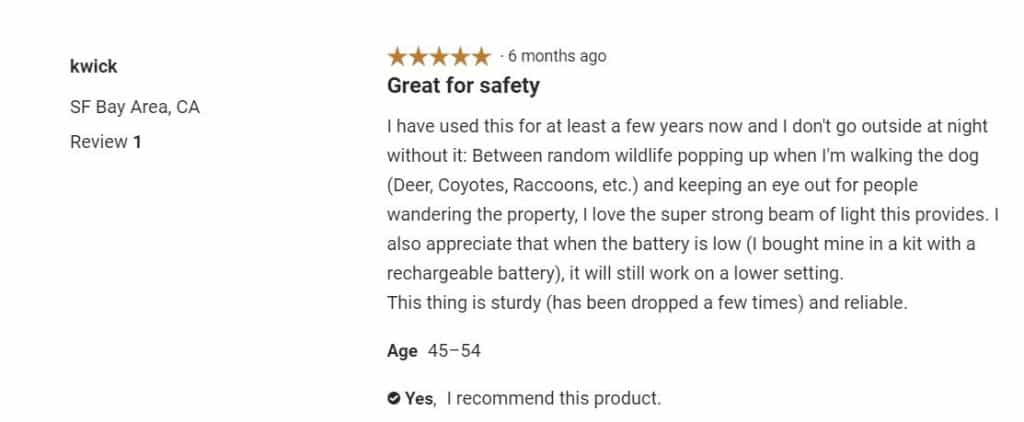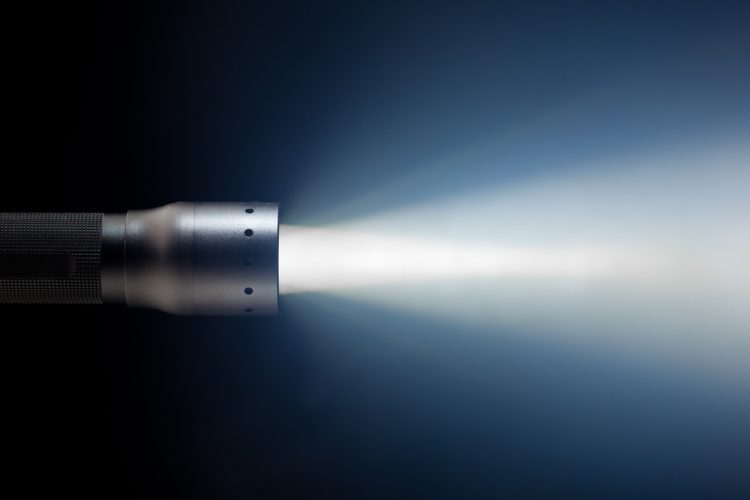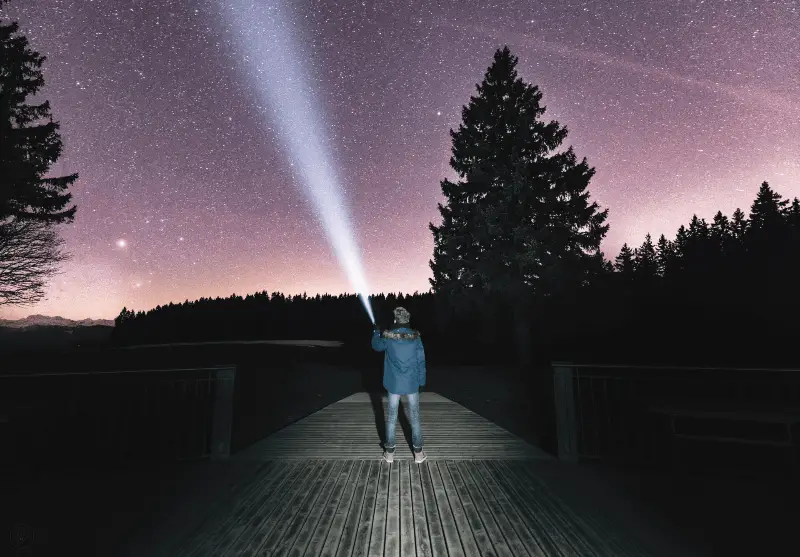7 Best Hiking Flashlights – Durable And Waterproof
Your first hike and camping combo trip may very well be the moment you realized why hiking with flashlights is a good idea.
Imagine stumbling in the dark, trying to answer the call of nature – or getting frustrated when your phone’s flashlight just isn’t bright enough.
Hunting down a good campsite?
No problem.
Campfire suddenly went out?
No problem.
Scaring away wildlife?
A flashlight does it all.
Hiking with flashlights prevents accidents and unexpected danger – but remember only the best will last! Our expert team tested 17 of the best hiking flashlights on the market to narrow down the top 7.
And our extensive research shows that the best hiking flashlight is Fenix PD35 TAC.
The top three hiking flashlights besides the Fenix are:
After consulting countless reviews and weighing in with fellow industry experts, we came up with a checklist of distinct features to consider:
- Weight & Durability
- Water resistance rating
- Beam type – spot, flood or adjustable.
- Levels of output – brightness levels and beam distance.
- Battery type – rechargeable or disposable.
- Additional features
So if you want to learn a thing or two about hiking flashlights, you will find this article super useful.
Without further ado, let’s get to it!
Our Top 3 Recommendations
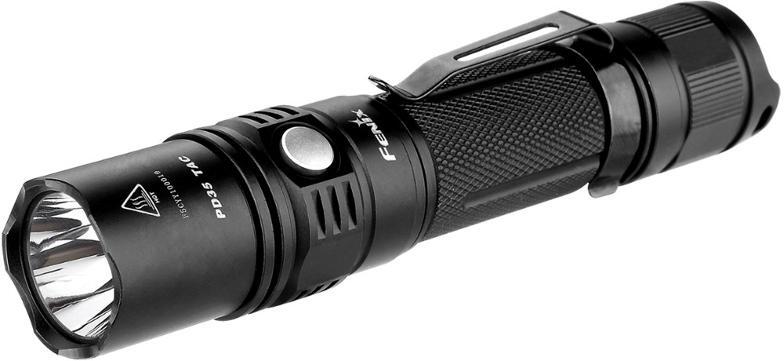
- Comes with 6 levels of output: from 8 to 1,000 lumens.
- Extremely durable, with a water-resistance rating of IPX8.
- Regulated output for consistent light output plus an inbuilt memory mode
- Features a holster, body clip and a lifetime warranty
- USB C charging 5000 mAh battery
- 692 m. of beam distance for convenience
- Super bright, with 2836 Lumens of max. light output
- Rugged and waterproof
- Incredible price to quality ratio
- Extremely compact - weighs 138 grams, battery included.
- Memory mode function applies to all 4 brightness levels; SOS mode not included for practical reasons.
- 1200 Lumens with 200 m. max. beam distance
The 7 Best Hiking Flashlights Compared
| IMAGE | PRODUCT | DETAILS | |
|---|---|---|---|
Top Choice  | Fenix PD35 TAC |
| Check Latest Price → |
Runner Up  | Thrunite Catapult |
| Check Latest Price → |
Top budget choice  | Wuben L50 |
| Check Latest Price → |
 | Ledlenser MT10 |
| Check Latest Price → |
 | Duracell |
| Check Latest Price → |
 | Bud K-P90 LED |
| Check Latest Price → |
 | Wissblue H1 Pro |
| Check Latest Price → |
#1 Fenix PD35 TAC
Turbo through dark forest trails with the tactical Fenix PD35 Flashlight, with a simple press of the side switch! While the 1,000 lumens output cuts through 200 meters of darkness, you can easily adjust between all 6 levels. It’s perfect for exploring more rugged landscapes, as an IPX8 water-resistance rating and anodized aluminum body offers high durability. The belt holster and wrist loop keep it connected to you for maximum comfort.
Unlike most flashlights, the Fenix PD35 backpacking flashlight operates on two modes: tactical and general. No surprise, since it's a tactical flashlight. You can play with the brightness setting and adapt brightness and beam type by cycling through the 6 output levels available on general mode.
Tactical mode simply streamlines your choices to low, turbo and strobe – used for higher risk or emergency situations.
Eco mode lets you enjoy some late-night reading, especially when using it on flood beam. To hone in on far-off spots, switch to spot beam and max out at 1,000 lumens of light on the high setting. The good thing is it has a low battery reminder. A really good flashlight.
The maximum beam distance reaches 200 meters for trail illumination. That gives you plenty of visibility ahead of you. We tested this and it works as advertised.
The versatile flashlight has an inbuilt memory mode so you don’t need to change settings from when you last used it. It makes it one of the most flexible and easy to use tactical flashlights on that list. The memory function is quite useful.
While switching between modes isn’t the most intuitive, many users found the manual extremely helpful. The side switch, which you use to switch between the operating types, is built into the casing to prevent accidental presses.
Built out of aircraft-grade aluminum for durability, this tactical flashlight is surprisingly light at 133 grams! It offers the right balance of features and price.
It's really a lightweight flashlight. The light is made of aero grade aluminum alloy. Best yet is how it works with your grip; the knurled handle makes the body non-slip and stops it from rolling.
It’s designed to be highly water-resistant, holding up to 2 meters of water immersion. It has an IPX8 waterproof rating. It's more than just water resistant.
There is a clip to allow hands-free use, but testers noted that it’s relatively frail. Secure with a band if possible. Still, the hands free operation allows you to clip it on your pack shoulder strap.
The durable flashlight also comes with a red light, convenient for night use. The red light mode allows you to see even better at night. I like all my flashlights to have a red light mode when I hike at night.
This edition runs on 2 CR123A batteries (AAA batteries), but you can opt for a rechargeable battery (18650) at additional cost if you prefer it over an AAA battery. So you have the option to run it on specialty batteries too.
The plus side?
Output is regulated to offer consistent light over battery lifetime. At its brightest output, the run time tips over 1 hour. The maximum run time is 140 hours. This is more than enough run time for regular hiking trips and any backpacking adventure.
Generally, buyers rate it a solid purchase thanks to the bright lighting and overall fit in hand. You can also secure it with the accompanying nylon belt holster and wrist loop for further carrying convenience. I personally like hands free usage.
Last but not least, we love the fact that the tactical flashlight has a lifetime warranty. Probably the best hiking flashlight on this list.
#2 Thrunite Catapult V6 LED
Like the ‘catapult’ in its name, this THRUNITE flashlight model throws an incredible amount of light with its SST70 lens – 2,863 lumens at 750 meters. Its versatility won us over, 6 brightness levels geared towards simple campsite use to hunting and rescue operations. This multi-use nature can be attributed to the aerospace-grade body and drop-tested construction too. All you need to do is remember to charge up the high-capacity battery before leaving the house!
The THRUNITE Catapult V6 backpacking flashlight is one of the most feature-balanced flashlights on the market. Weighing 472 grams, it’s actually with a super compact design for such a powerful thrower! It won't take space at all in your hiking backpack. And it's as durable as a tactical flashlight with impressive impact resistance.
The SST70 LED bulb offers a stunning throw depth of 750 meters. It’s made for field searches and location spotting. It also has a night light mode for further convenience. In this mode, the output beams down automatically, but brightens up again once you move the torch.
So, it's a reliable flashlight you can count on during extremely dark conditions. It acts as a keychain flashlight.
You might think the maximum output of 2,836 lumens is an overachiever, but it comes in handy for signaling; even scaring of wildlife. Rest assured, you have enough light even for the darkest nights, especially on full brightness.
There are 6 lighting modes categorized into daily modes and special modes. The former offers low, medium brightness setting and high brightness settings for general hiking and camping needs. So it makes an ideal use as a flashlight for camping. I usually use it on medium brightness. All good hiking flashlights have that feature.
The special mode features turbo, stroke and firefly for rescue operations, signaling and emergency use. Yes, this one's a feature-rich led flashlight.
Thanks to the rechargeable 5000mAh capacity battery (no AAA batteries here), you can run this led flashlight for a long time – up to 70 days.
It’s perfect for long-hauling hikes where you have to go off-grid. The battery indicator will remind you to charge. The rear button is convenient too, allowing you to navigate through the different modes.
Other features make this led flashlight suitable for heavy duty use, including its aluminum body and waterproof seals. Not only will it survive drops up to 1.5 meters, but it has a waterproof rating to IPX8 standards, adding to versatile use.
While it only offers a spotlight beam, it’s bright enough to illuminate the vicinity. Definitely a good flashlight for very dark areas.
Unfortunately, the downside of this high-powered beam is that it heats up when running on turbo – not so great for extended use in hot climates.
Still, our team was impressed by the brightness and reach of this thrower – it has one job and it does it well. One of the best backpacking flashlights on this list.
#3 Wuben L50 LED
The WUBEN L50 LED Flashlight is efficient to the max. At only 138 grams, the 1,200 lumens output packs an unexpected punch. Luckily, you can adjust through the 4 light modes and emergency strobe. Field-tested and offering high water-resistance, the flashlight adapts to the terrain – the flexible battery set up (from inset rechargeable to insertables) is a plus too! You can keep an eye on battery level with the warning function.
If you're looking for the best bang for the buck, you may call this one the best flashlight. It's a solid budget option.
Lightweight, affordable, and impact resistant, the aircraft-grade aluminum casing of WUBEN L50 approves it for heavy duty use. Just like a tactical flashlight,
Not only highly waterproof with a waterproof rating of IPX8 to allow it prolonged immersion, its dustproof qualities protect the internal circuitry for longer life.
Thanks to the OSRAM P9 LED bulb, the backpacking flashlight handles the 1,200 lumens max output without generating too much heat. It won’t burn in your hand.
For a led flashlight that uses a flood beam with a hot center, the 200 meters max beam distance is pretty awesome. This model comes with 4 basic light modes and an SOS mode: Eco (just 5 lumens), low, mid and high.
There is a quite convenient memory mode function – turn on to the setting you were last using. I suggest switching to a lower brightness level before turning it off or risk unexpected brightness the next time you use it! Use full brightness only when you need it to also preserve battery life. Otherwise, operate it on low setting if possible, of course.
Powered by a rechargeable lithium battery (no AAA batteries needed), it’s extremely cost-saving over time. One charge lasts 1.5 hours on high mode and 143 hours on Eco mode. Long live rechargeable lithium batteries!
What makes it stand out from other models is that this led flashlight is also compatible with standard AA batteries. That’s an easy backup option in case you’re off-grid and have no way to charge.
You’ll receive a lower power warning when runtime drops to 30 minutes on your current light mode. It’s a handy indicator to return to somewhere safe (with light).
It’s highly recommended for more extreme conditions, as even the USB port is designed to keep water out. It’s small enough to fit in your pockets too. And it's effortless to switch between the different modes.
And isn’t that what you need from a hiking flashlight?
#4 Ledlenser MT10
Don’t worry about overheating your Ledlenser MT10 Flashlight – its temperature control system allows maximum LED beam output without burning up. A battery indicator shows how much of 144 hours use you have left, great for extended trips outdoors. With its transportation lock, you won’t lose power with an accidental switch on either! Still, its best hiking feature is the rapid focus beam - locking on objects far and near seamlessly.
This is a small but highly functional torch with a rugged construction.
Many buyers praise the Ledlenser MT10 backpacking flashlight for its patented advanced focus system – the rapid focus coming in handy during “think fast” scenarios.
With just a simple single-handed motion, you can switch from the beam from flood to focus and back. Other flashlights on that list don't have that feature.
While maximum brightness doesn’t hit 3,000 lumen output of Ledlenser’s bigger models, this handy 5 by 1.3-inch flashlight tops a generous 1,000 lumens and maximum distance of 180 meters. So it's still super bright for most needs and a reliable light source.
What a bright idea, right?
The lowest brightness is 10 lumens, perfectly comfortable for campsite use.
Adjust the lighting modes by clicking the button; there are 3 brightness levels. You can program the order of brightness, a nifty feature that ensures you won’t be blinded upon turning it on.
One of the 3 light functions is a defense strobe mode, great for signaling even for long distances. It's very easy to switch between the different modes.
Battery life is extremely generous, lasting as long as 144 hours per charge. It takes 4 hours to fill the rechargeable lithium battery. So it doesn't just have a single AA battery.
The USB charger makes it convenient to power up. It has a charging cable too. The charge and battery indicator makes it easy to keep track of power usage so you know how many hours of light you have left on your backpacking trips.
The streamlined design is perfect if you prefer compact models. While it’s not made for super rugged use as the Fenix PD35, the IPX4 water-resistance rating protects it from the elements.
I only wish it had a magnetic base allowing you to place it on metal surfaces, when needed. But that's definitely not a deal breaker.
A small feature I appreciate is the transportation lock. While the flashlight comes with a clip-on carrying case, the transportation lock prevents accidental button presses – something that often might occur in the dark, especially on technical terrains.
The only complaint customers have is how close to the body the clip is. While it’s great to shove in tight spaces, the rigidness makes it hard to actually use the clip.
This one's among the best backpacking flashlights on that list. And it has a pocket clip for hands free usage.
#5 Duracell 2500 Lumen
Need a flashlight that can handle heavy use and the extreme outdoors? Duracell’s Focusing Flashlight is encased with aircraft-grade aluminum to be virtually indestructible. And we tested it. Featuring 3 light settings, quick focus beams and an extremely powerful output of 2,500 lumens, it’s built to last. Simply power it up with Duracell batteries and hit your hiking trails confidently.
We tested this hiking flashlight on several forest hikes and it amazed us with durability and ease of use. If you're looking for a simple, yet durable, impact resistant device, this is the best flashlight for you.
It might not have fancy features such an anti reflective coating on the lenses or tiltable head, but it's compact, bright and durable. Everything you need for clear night vision. Really a quality light source.
At 666 grams, Duracell’s Copper Dot Focusing backpacking flashlight is among the heaviest on our list. It's a nifty device with a handheld size.
I hope you're not afraid of a little bit of added weight. But for those who are looking for a solid, classic model, this one is suitable for work, home and outdoor use.
It's a decent traditional flashlight. It runs on disposable batteries. It actually comes with integrated batteries. Not just with a single AA battery.
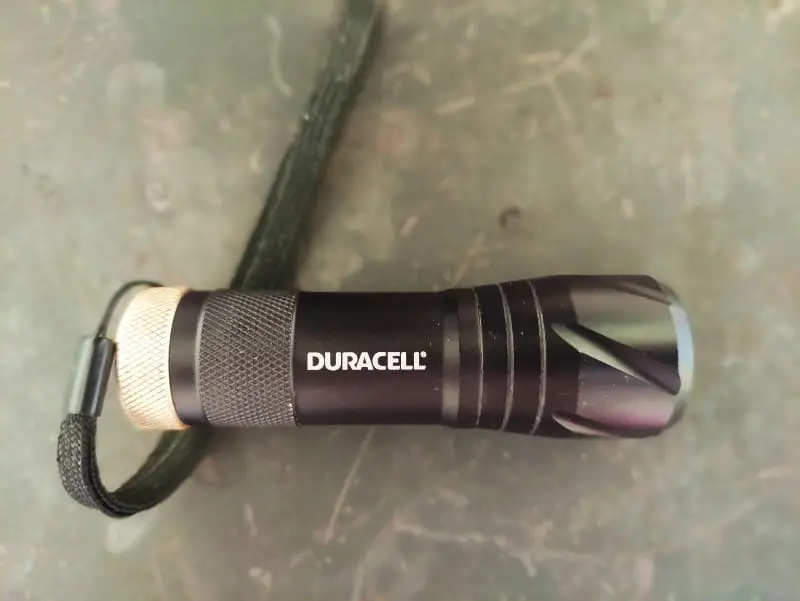
We tested the Duracell and it wowed us with simplicity and durability.
Like most flashlights on this list, it’s mainly made of aircraft-grade aluminum to protect against rough surfaces and drops. The hand grip is very comfortable.
The casing material also contributes to the water-resistant quality – with a waterproof rating of IPX4, it’s safe to use in light rain conditions. Still, be careful with the battery compartment, as it might get wet easily. If water penetrates inside and stays there for a long time, even new batteries won't save you.
What really makes it stand out is its max output of 2,500 lumens – you’re hard pressed to find handheld flashlights with this much power. Penetrating a depth of 150 meters, the light runs for 3 hours on the brightest setting. Not the flashlight with the longest beam throw on our list, but still enough for most occasions.
While the flashlight only offers 3 light modes (low, high, strobe), the Copper Dot Focusing technology more than makes up for it. My favorite one is the strobe mode.
Simply slide the head for a quick and smooth transition between flood and spot beam. Long-distance observation and large-scale lighting is a go!
It doesn't have a red light for enhanced night vision, though.
Batteries are included but unfortunately, they’re not rechargeable. Still, the 9-AA Duracell batteries are easily accessible and made to be compatible. It lasts 22 hours on low light, relatively long for alkaline batteries.
If you don’t like complicated flashlights with tons of features, this hiking flashlight is for you. Not many backpacking flashlights are minimalistic these days.
You might need extra batteries, though if you're going to use it extensively on the brightest setting. Bringing spare batteries is a good tip, anyway for safety purposes.
#6 BUD K-P90 LED
It’s hard to believe it until you see it – make sure to point the bulb away from you before beaming up its “90,000 high lumens” LED. Its high specs include IPX65 water-resistance, USB rechargeable batteries, sturdy aluminum alloy and a beam distance of over 1650 feet. Offering both large flood lights and focused beam, it’s the perfect tool to explore dark caves and dense forested areas.
The 18cm x 6cm dimensions of the BUD K flashlight contribute to a weight of 700+ grams – not insignificant for a hiking flashlight. Don't mind the added weight, though. Its heavy-duty design makes it perfect for extreme terrain.
But is it the best backpacking flashlight available?
Let's see.
Wrapped in high-quality aluminum alloy, you don’t have to worry about it breaking when dropped. The material is chosen for its anti-abrasive properties while making it as lightweight as possible. The best flashlights are more than just durable.
Additionally, the high water-resistant quality doesn’t just protect it from splashing water, but also lets it work in freezing weather.
Thanks to the CREE LED bulb, you can tilt your 90,000 lumens light into shadowed crags of deep gorges and it’ll light up over 1650 feet of distance. It's like a powerful camping lantern. It's super bright. The night vision becomes almost like a day vision with the turbo output.
Isn't' that a remarkable beam throw?
This gives you plenty of warning in foggy and hazy areas. It's like a real moonlight mode. it's like you have a camping lantern with you. You don't need a brighter flashlight!
The high lumen output is too bright for you?
You can opt between the 3 brightness settings: low, high and flash for emergency use. It also has an ergonomic grip to hold the light securely.
The beam is flexible, the telescopic zoom allowing huge area coverage when using floodlights and deeper penetration with the focused beam. Previous users have also reported that the flashlight seems to be self-regulating.
One well-praised feature is the long battery life – it lasts up to 10 hours on medium lighting. You don’t have to worry about battery running out on a day hike. Plus, you can always recharge it even on a solar panel, if you bring one.
The battery itself, a high-performing lithium battery, is rechargeable. The type C USB is compatible with plug sockets, computers, laptops and power banks, making it convenient to recharge.
This is the brightest of all backpacking flashlights on that list.
#7 Wissblue H1 Pro
If you’re looking for a military grade flashlight, the WISSBLUE H1 Pro has impressed many a police force and veteran. Stainless steel head, IPX8 waterproofing, corrosion and drop resistance makes it suitable for all environments – we haven’t even mentioned the 4,000+ lumens output yet! Read on to see why else it is a crowd favorite.
Hunting, fishing, hiking and embarking on rescue missions – you can do it all when your flashlight sports an aviation-grade aluminum body and hardy material treatments.
A small form factor flashlight, this Wissblue model is considered by many as the best backpacking flashlight for its price and features. We took in on a hiking trip that involved caving and it impressed us with its intuitive user interface.
Not only does the stainless-steel head protect the lenses, it can be used for defense against animal and human attacks (although we hope you opt to run instead of fight).
Speaking of protective elements, the IPX8 waterproof rating holds up against rain, snow and immersion; coming in handy in undesirable conditions and heavy rain. It can stay under 1 meter of water for up to four hours without issues. The best flashlights have high waterproof rating. This one's also shock resistant.
Switch between 4 lightning modes (low, medium, high, flicker) depending on necessity. Low light works well to illuminate inside tents, while the flicker settings work well to signal.
With a max output of 4000+ lumens and a 3000 feet reach, you won’t get lost anytime soon. Often you need high output when walking in vast open space areas.
The rechargeable battery runs up to 200 hours per cycle; 75 minutes on maximum brightness. So that you won’t be caught unaware, the flashlight will flash when the battery is low. You can charge it easily with a battery pack or even via a solar panel, for example.
Similarly, output regulators are fitted, so that it automatically reduces brightness when the battery starts to overheat. Very nice!
To keep close, simply make use of the detachable anti-roll ring it comes with, especially when resting on a rocky surface.
From our research, we noticed that many reviewers are security guards, police or retired military. It is given thumbs up for being powerful, compact and highly efficient. Not all backpacking flashlights have all these features combined. It's a great addition to your outdoor gear.
Ultimate Buyer’s Guide For Hiking Flashlights
If you want to study what backpacking flashlights are the best on the market, here are some important features to look out for. These will help you choose the best backpacking flashlight for your needs.
Before you fish your cards out, make sure you’re making an educated choice. To eliminate any headshakes and regret when your flashlight fails you in a pinch, we’ve pinpointed certain features to check when looking for the best flashlights.
- Battery – Battery is extremely important as it will define your output and runtimes. We cover that point more in-depth below, so continue reading. We also discuss AA batteries and AAA batteries.
- Switch type - what's the best?
- Twist switch – You turn it on by twisting the head; this controls brightness modes as well. The biggest downside is that you need two hands for this.
- Tail switch – Press firmly on the button at the end of your flashlight to turn it out; another press can bring you to a dimmer mode.
- Side switch – Either a button or slide, the side switch is perhaps the most intuitive and can be operated one-handed. We recommend getting a slide side switch to prevent accidental button presses.
- Weight – You certainly don’t want to be lugging a brick with you, especially on an overnight trek! Keep in mind that battery-operated flashlights tend to be heavier. The case material contributes to weight too. Titanium, for instance is a lot lighter than stainless steel.
- Durability – Some specify drop-tests or labelled “tactical”, which is a good indication of higher impact-resistance. The housing material plays a significant role here. Titanium is the strongest and lightest material.
- Waterproofness – Depending on activities you’ll potentially use it for, you may require lower or higher waterproofing rating. Pay attention because on most cheap flashlights, the battery compartment could easily get wet.
- IPX4 – For basic use. Can survive light rain.
- IPX5/6 – Good for heavy rain usage but keep out of water.
- IPX7 – Can submerge up to 1 meter of water.
- IPX8 – Can submerge more than 1 meter; only use in for scuba diving.
- Beam distance – How far does your light beam reach? You want to be able to adjust the depth of the beam depending on situation and space.
- Beam type – The two beam types, spot and flood, decide how your light spreads. You need both high beam and low beam in different situations.
- Bulb type – most flashlights come with LED bulbs these days.
- Output of the light – The higher the lumens, the higher the maximum output. How many lumens do you need for night hiking? We cover that in more detail below. So read on.
- Lockout feature - a lockout feature or lockout mode is more important than you think. It can prevent battery drain due to accidental operation.
- Light modes – The more light modes you’ve got, the more flexible your flashlight use. If possible, find a flashlight with a memory function. It will remember what mode was last used.
- Mid to high – Being able to use at a third or half brightness to maximum brightness.
- Nightlight – Just enough to find things in the dark without blinding yourself.
- Red light – Red light is great for nighttime use; can also be used as location signal.
- Strobe – Quick, bright flashes that act as emergency blinkers.
- SOS – Some emergency SOS modes blink out SOS in Morse.
- Clip feature – Should your flashlight be clippable or not?
- Pro – With a pocket clip, for example, you get a convenient, hands-free flashlight. You can even clip it as a tent ceiling light, or snapped onto your backpack strap instead of demanding internal space.
- Con – Losing your flashlight if it’s not clipped properly; it might also snag on loose items. Most flashlights have a pocket clip.
- Price - not a negligible factor. Note that in most cases, good light requires good investment.
Tips On Flashlight Batteries
One feature to pay special attention to is battery. You want to consider both its shelf life and environmental impact.
battery-operated flashlights vs USB rechargeable flashlights
The pros and cons of both types are surprisingly balanced. For instance, a mutual con is that both regular batteries and rechargeable ones inevitably run out of power.
No matter if you have three AAA batteries to spare, eventually they will run out of power. Power output also depends on the type of battery you’re using – more details below.
The pros and cons of regular (AAA) batteries include:
- Readily accessible
- Backup batteries are easier to pack in bulk.
- No-fuss disposal and no need to replace parts if battery dies on its own accord.
- Not environmentally friendly at all!
- Limited capacity due to size.
- Potential hazard if exposed to elements.
In brief, the main difference between AAA batteries and AA batteries is that AA batteries are used in devices that consume more power.
On the flip side, the pros and cons of rechargeable batteries are:
- Much more environmentally friendly since you don’t just use and dispose.
- Rechargeable flashlights are often pricier but are money savers in the long run.
- Good quality rechargeable batteries can last several hundred charge cycles.
- Better sealed; less risk of water damage.
- Requires a ready electricity supply to recharge – like a battery pack.
- Required power source makes it more grounded; may not be so good for extended trips off-the-grid.
- Have to pack an additional USB cable for charging; doesn’t work without one.
What type of battery should I use?
Like flashlights, batteries are not made equal. You’ll have to weigh between cost, size, weight, capacity, and potential environmental effects.
- Alkaline – Cheap and found everywhere, these are the most common batteries. They are not built to last. Alkaline batteries are low energy density, meaning it doesn’t store much power. They’re typically made disposable and not environmentally friendly. Even though most of the time they work just fine, they are prone to leaking. That’s way it's advisable to turn on your flashlight once a week to prevent leaking.
- Lithium – Considered the best compromise between energy efficient and weight, lithium-powered flashlights allow long runtimes at maximum output. They have a longer life because they have a slow self-discharge rate. You need lithium batteries if you use your flashlight in freezing temperatures on winter hikes. In such cases, the best size you need is CR123A, so make sure your flashlight operates on CR123A battery. Again, in such scenarios, lithium batteries are preferred.
- Make sure to get rechargeable flashlight batteries. You can also get rechargeable battery packs. A rechargeable battery provides more security on longer treks.
- NiMH – Costly but well-worth the investment, these rechargeable batteries are designed for long life. While the energy density decreases over time, you’ll get a few hundred charge cycles out of it.
I highly recommend buying rechargeable battery-powered flashlights whenever possible, as these reduce our carbon footprint and save you money over time.
The only exception would be rechargeable alkaline batteries. They’re not very cost effective since they fail after a few charge cycles. In any case, note that larger flashlights can handle heavier batteries, that have longer lifespan.
How do I keep the batteries running for longer?
Battery life on flashlights depends on three factors: type of battery, capacity of battery and how long you keep the lights on for. Aim for ‘efficient use’ rather than ‘the larger the better’.
- Flashlights with multiple brightness settings extend battery life since you won’t be using it on maximum brightness the entire time.
- Batteries are affected by temperature fluctuations. Avoid leaving them out in the sun or shoving them into the cold.
- Seek higher battery capacity. All batteries have their natural run-times so choose appropriately.
- Only charge when the battery is flagging. This extends battery shelf life.
- This one is obvious - only use the flashlight when necessary!
Frequently Asked Questions About Flashlights For Hiking
We curated a short list of some popular questions that people have about backpacking flashlights.
Wanna see it?
Read on.
What’s the best beam type?
From my years of hiking, I found that you want a flashlight that has both spot and flood options. In fact, many flashlights now boast both.
- Spot – a focused beam great for illuminating distance; not so great for peripherals.
- Flood – sweeping beam that shows an extensive area; shorter depth means better for immediate area exploration.
- Adjustable – you can slide between the two beam types flexibly.
How to measure light output?
Brightness is measured in Lumens – how bright the output of the light appears. All you really need to know is that the higher the number, the brighter the light. Most specs include maximum Lumen capacity for product comparison.
So, how many Lumens are bright enough for night hiking?
If you simply need some light for close up tasks, 10-20 Lumens are enough. 150-200 Lumens can cover up to 250-meter distances, while anything between 200-500 Lumens offers a much sharper light up to 300 meters.
You don’t require anything above that unless you’re caving or participating in search and rescue.
How to decide on the light output and runtime?
What activities did you plan for? How long will you be off-grid? How much are you willing to pay?
For regular hiking purposes, we suggest a balanced output and runtime. You most likely won’t need to operate your flashlight on maximum brightness, meaning you can stretch out its use. The run time is normally given for each light mode – check it out! If you’re doing more specific activities however, prioritize. Going cave diving? You’ll want higher light output. Going on a two-week expedition? The longer your battery lasts, the better.
If you’re playing the long game however, get a flashlight that has regulated output. It’ll maintain consistent light output over time.
Flashlight or Headlamp?
Some people consider backpacking headlamps to be flashlights, just worn on the head. They’re not quite the same – nor do you use them for the same activities/purposes!
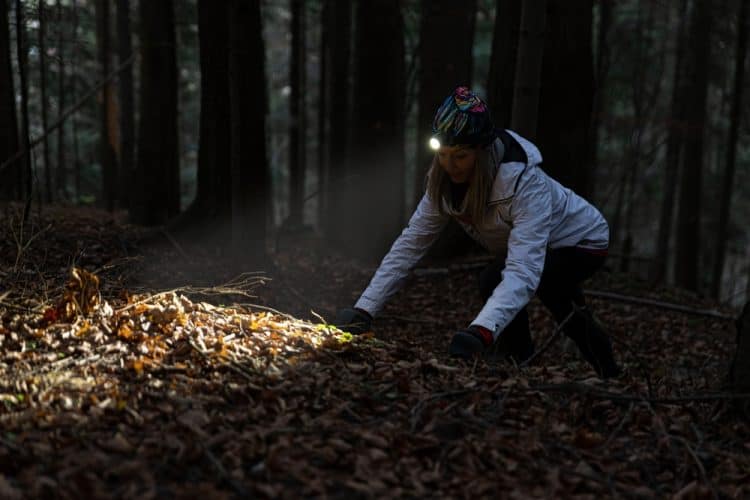
Headlamps allow your hands to be free, but at the same time their brightness level and battery life are shorter as compared to flashlights.
The biggest advantage of using headlamps is being able to use it hands-free. Many backpacking headlamps are easily adjustable and light. They don’t take up much storage space. I’ve used headlamps when I go rock climbing, or when my hike requires hand support.
On the other hand, headlamps don’t carry the same brightness and battery life as flashlights do. They tend to be flood beams rather than spot beams, meaning no long-distance spotting.
Another issue is flexibility. It only illuminates in the direction your head turns to – not great for general lighting purposes. It's a bit restrictive and somehow similar to backpack clip-on lights.
Generally, hiking with flashlights is best.
Final Verdict
How did you find our ultimate guide to the best backpacking flashlights?
Again, based on hours of research and testing, our top choice for a hiking flashlight is the Fenix PD35 TAC flashlight.
While brightness certainly is a factor to consider, don’t forget that other qualities are important too. Because flashlights can be used for multiple purposes, not just hiking, you want one made of durable material and a certain degree of climate proofing.
Likewise, beam types are important as they highlight different areas for you.
Ask yourself: What activities will I be doing? Do I have a specific use for my flashlight or just for general purposes? How long will I be out hiking and how long should the runtime be?
Asen Stoyanchev
Founder of this website, Asen is a passionate hiker and writer who is also a gear nerd. He’s been featured on many established hiking websites where he gives hiking advice & tips. When he is not trekking with his family or friends, he is writing articles and product reviews. Asen spends most of his time in Bulgaria but he constantly travels the world in seek of more unforgettable experiences. Read more about Asen here.

